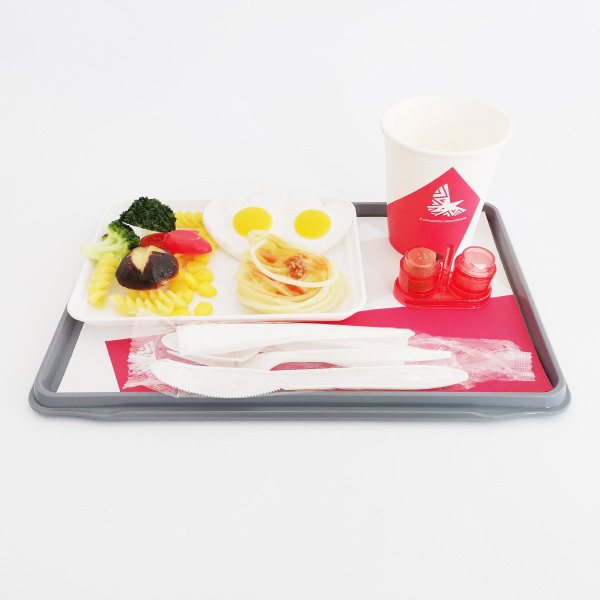Choosing the Perfect Rotable Tableware Set for Airlines: A Comprehensive Guide
Release Time:
Aug 07,2025
Choosing the Perfect Rotable Tableware Set for Airlines: A Comprehensive Guide
Table of Contents
- Understanding Rotable Tableware
- Importance of Choosing the Right Tableware for Airlines
- Factors to Consider When Choosing Rotable Tableware Sets
- Different Types of Rotable Tableware Sets
- Enhancing Brand Image and Passenger Experience
- Case Studies: Successful Implementations
- Future Trends in Airline Tableware
- Conclusion
- Frequently Asked Questions (FAQs)
Understanding Rotable Tableware
Rotable tableware refers to the durable and reusable dining equipment used aboard aircraft, specifically tailored for high-volume service. These items often include plates, bowls, cups, and utensils designed to withstand the rigors of in-flight service while maintaining an appealing aesthetic. The right rotable tableware set not only elevates the dining experience but also aligns with an airline's brand identity.
Importance of Choosing the Right Tableware for Airlines
In the competitive airline industry, every detail counts. The choice of rotable tableware plays a crucial role in enhancing passenger satisfaction. Effective tableware can improve the overall dining experience, contribute to brand loyalty, and even influence customer perceptions of the airline's quality. Airlines that invest in high-quality, aesthetically pleasing tableware demonstrate a commitment to their passengers' comfort and satisfaction.
Factors to Consider When Choosing Rotable Tableware Sets
Making the right choice goes beyond aesthetics. Several key factors must be taken into consideration to ensure the selected tableware meets the diverse needs of airline operations.
Material Selection
The material of rotable tableware directly impacts its durability, weight, and ease of cleaning. Common materials include:
- **Melamine**: Known for its durability and lightweight nature, melamine is a popular choice for airlines. It is shatter-resistant and can mimic the appearance of ceramic without the associated weight.
- **Stainless Steel**: Often used for utensils and some serving dishes, stainless steel is both durable and easy to sanitize, making it ideal for high-turnover environments.
- **Bamboo Fiber**: As sustainability becomes a priority, bamboo fiber tableware has gained popularity. It is biodegradable, eco-friendly, and offers a unique aesthetic.
Selecting the right material is crucial for balancing durability, cost, and passenger satisfaction.
Design and Aesthetics
The design of tableware should reflect the airline's brand identity while remaining functional. Considerations include:
- **Color Schemes**: Colors can evoke emotions and influence perceptions. A well-thought-out color palette can enhance the dining experience.
- **Shape and Size**: The design must facilitate efficient use of space in meal service. Plates and bowls should be shaped for ease of stacking and storage while accommodating varying portions.
- **Branding Options**: Customization options, such as logo placements, can enhance brand visibility and create a cohesive dining experience.
A well-designed tableware set can elevate the overall perception of the airline.
Sustainability and Eco-Friendliness
With increasing consumer awareness regarding environmental issues, sustainability in airline operations has gained traction. Airlines are now prioritizing eco-friendly materials and practices, such as:
- **Recyclable Materials**: Choosing rotable tableware that can be recycled at the end of its life cycle reduces waste.
- **Production Processes**: Selecting manufacturers who use sustainable practices contributes to the overall environmental effort.
- **Life Cycle Assessments**: Understanding the environmental impact of tableware throughout its lifecycle helps airlines make informed decisions.
Adopting sustainable practices can enhance the airline's reputation and appeal to environmentally conscious travelers.
Cost-Effectiveness
While quality and aesthetics are important, cost considerations cannot be overlooked. Airlines must evaluate:
- **Initial Investment**: The upfront cost of purchasing rotable tableware sets must fit within the airline's budget.
- **Long-term Durability**: Investing in high-quality materials may yield higher initial costs but can lead to savings over time due to reduced replacement needs.
- **Operational Efficiency**: Efficient cleaning and storage solutions can reduce labor costs and streamline in-flight service.
Finding a balance between quality and cost is essential for long-term financial viability.
Different Types of Rotable Tableware Sets
Airlines often opt for a mix of tableware styles to cater to different meal services. These may include:
- **Economy Class Sets**: Generally more utilitarian, designed for high-volume use and easy cleaning.
- **Business Class Sets**: Often more elegant and designed to enhance the dining experience, offering premium materials and sophisticated designs.
- **First Class Sets**: Luxury-focused, using high-end materials and custom designs to create an unparalleled dining experience.
Understanding the nuances of different service classes is essential for selecting the right tableware.
Enhancing Brand Image and Passenger Experience
Tableware sets contribute significantly to the overall brand image of an airline. High-quality, well-designed tableware can create a memorable dining experience, encouraging passengers to return. Airlines that prioritize passenger experience through thoughtful tableware choices often see increased customer loyalty and enhanced brand perception.
Case Studies: Successful Implementations
Examining successful implementations can provide valuable insights. For example, a leading international airline revamped its tableware selection, opting for sustainable materials and streamlined designs. As a result, they reported improved passenger satisfaction ratings and a stronger brand image.
Future Trends in Airline Tableware
The airline industry is evolving, and so is the approach to tableware. Emerging trends include:
- **Smart Tableware**: Incorporating technology into tableware, such as plates with embedded temperature controls, to enhance the dining experience.
- **Customization**: Increasing personalization options for passengers, from meal choices to unique tableware designs.
- **Health-Conscious Options**: Offering tableware that aligns with health trends, such as portion control designs or materials that promote hygiene.
Staying ahead of these trends can position airlines favorably in the competitive market.
Conclusion
In conclusion, choosing the right rotable tableware set for airlines involves a multifaceted approach. By considering material selection, design aesthetics, sustainability, and cost-effectiveness, airlines can enhance passenger experiences and reinforce their brand identity. As the industry evolves, staying informed about trends and successful implementations will be crucial for maintaining a competitive edge.
Frequently Asked Questions (FAQs)
1. What is rotable tableware?
Rotable tableware refers to reusable dining equipment used in airlines, designed to be durable and aesthetically pleasing while meeting the demands of in-flight service.
2. Why is the choice of tableware important for airlines?
The right tableware enhances the passenger dining experience, supports brand image, and can influence customer satisfaction and loyalty.
3. What materials are commonly used for airline tableware?
Common materials include melamine, stainless steel, and bamboo fiber, each with its own set of benefits in terms of durability and sustainability.
4. How does sustainability play a role in choosing tableware?
Sustainability is increasingly important as airlines seek to reduce their environmental impact. Eco-friendly materials and processes contribute to this effort.
5. What future trends should airlines consider regarding tableware?
Airlines should look out for trends such as smart tableware, increased customization, and health-conscious designs that enhance the passenger experience.




